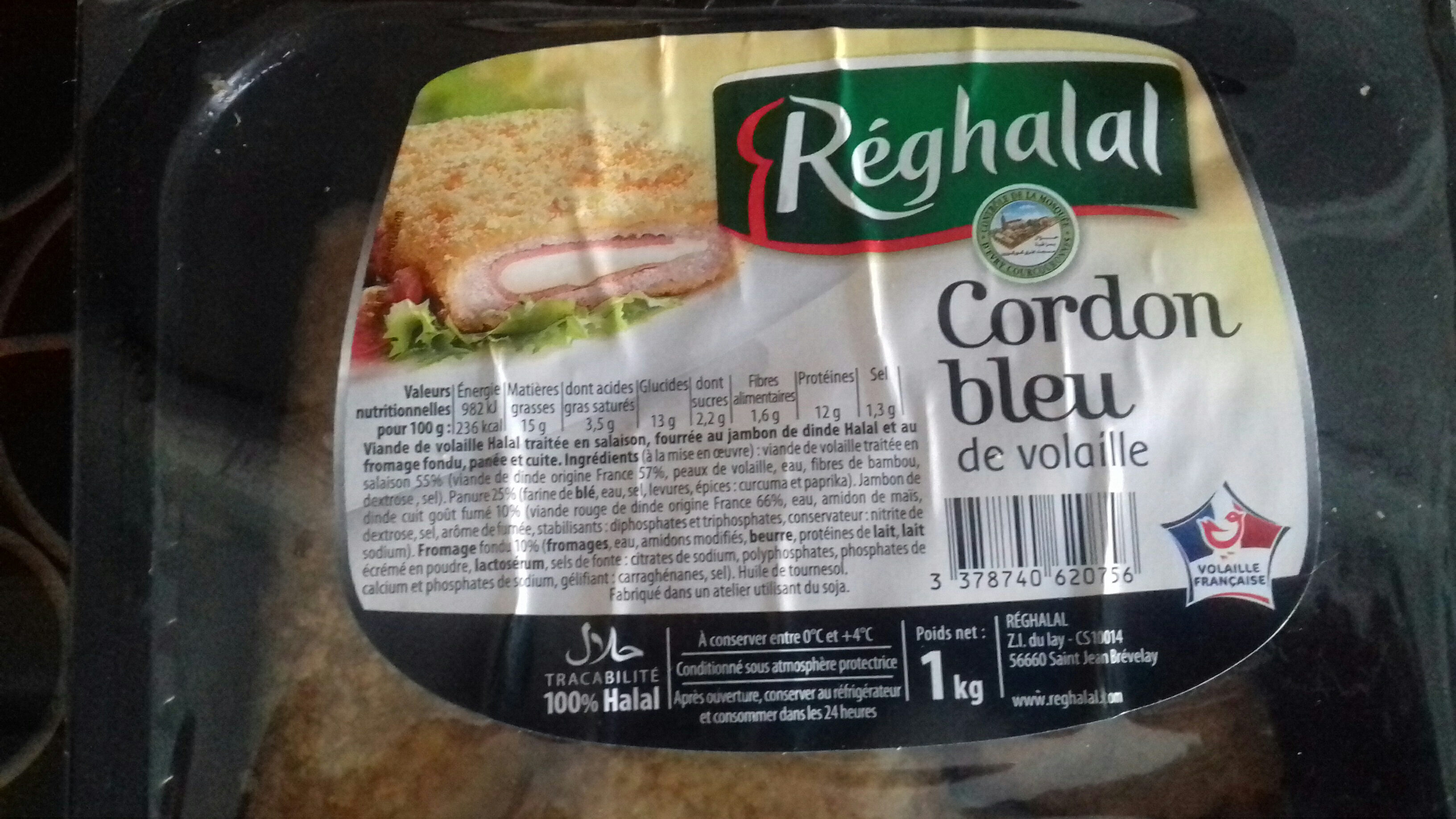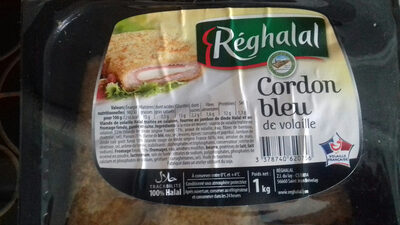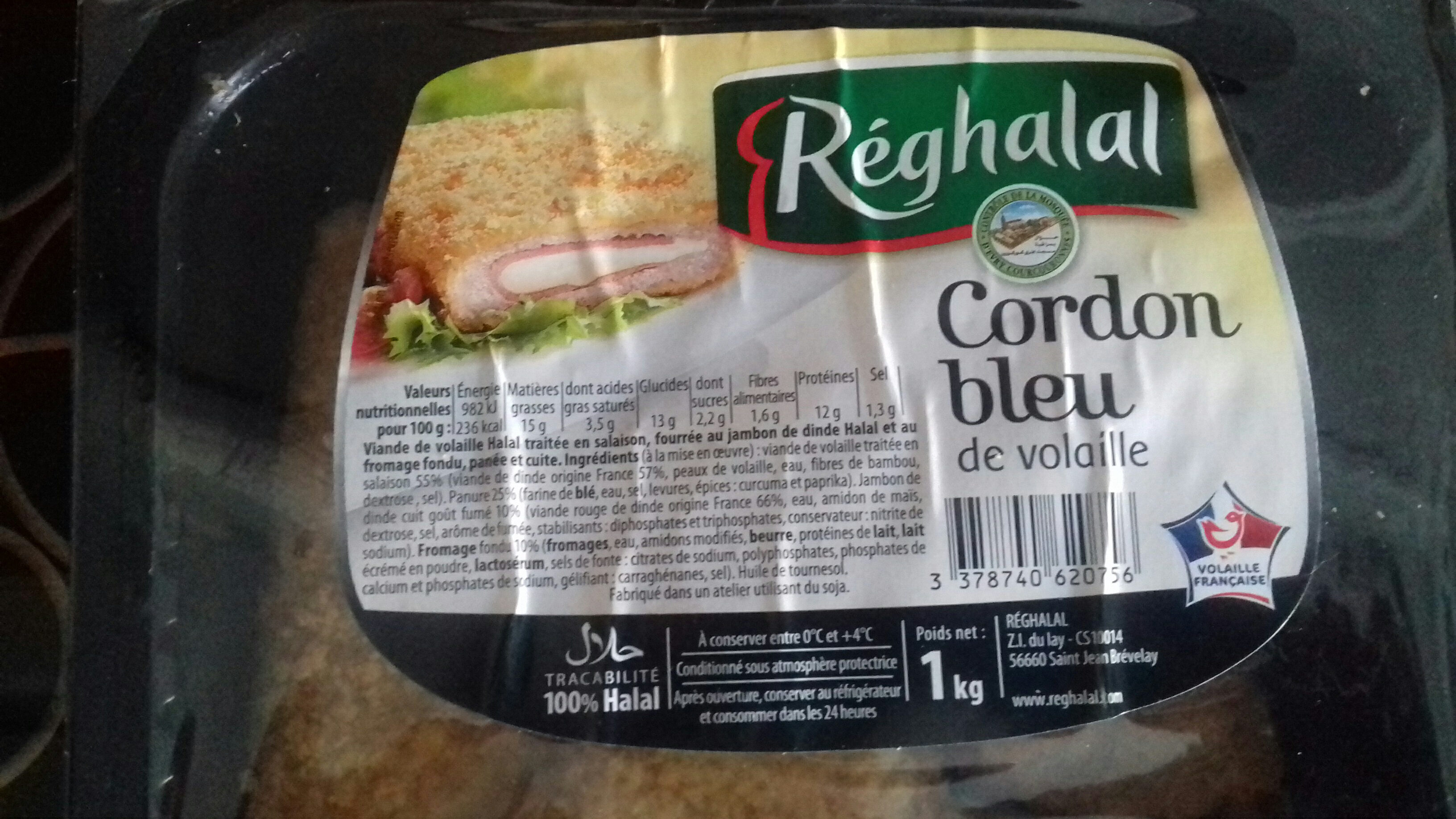Help us make food transparency the norm!
As a non-profit organization, we depend on your donations to continue informing consumers around the world about what they eat.
The food revolution starts with you!
Cordon bleu de volaille - Reghalal - 1 kg
Cordon bleu de volaille - Reghalal - 1 kg
This product page is not complete. You can help to complete it by editing it and adding more data from the photos we have, or by taking more photos using the app for Android or iPhone/iPad. Thank you!
×
Barcode: 3378740620756 (EAN / EAN-13)
Quantity: 1 kg
Brands: Reghalal
Categories: Meats and their products, Meat preparations, Meats, Poultries, Turkey and its products, Breaded products, Turkeys, Turkey preparations, Cordons bleus, Poultry cordons bleus, Turkey cordons bleus
Labels, certifications, awards:
Halal, fr:Contrôle de la mosquée d'Évry-Courcouronnes

Origin of ingredients: France
Stores: carrefour.fr
Countries where sold: France
Matching with your preferences
Health
Ingredients
-
27 ingredients
French: viande de volaille traitée en salaison 55% (viande de dinde origine France 57 %, peaux de volaille, eau, fibres de bambou, dextrose, sel). Panure 25% (farine de blé, eau, sel, levures, épices:curcuma et paprika). Jambon de dinde cuit goût fumé 10% (viande rouge de dinde origine France 66%, eau, amidon de mais, dextrose, sel, arôme de fumée, stabilisants: diphosphates et triphosphates, conservateur:nitrite de sodium). Fromage fondu 10% (fromages, eau, amidons modifiés, beurre, protéines de lait, lait écrémé en poudre, lactosérum, sels de fonte: citrates de sodium, polyphosphates, phosphates de calcium et phosphates de sodium, gélifiant carraghénanes, sel). Huile de tournesol.Allergens: Gluten, MilkTraces: Soybeans
Food processing
-
Ultra processed foods
Elements that indicate the product is in the 4 - Ultra processed food and drink products group:
- Additive: E14XX - Modified Starch
- Additive: E407 - Carrageenan
- Additive: E450 - Diphosphates
- Additive: E451 - Triphosphates
- Additive: E452 - Polyphosphates
- Ingredient: Gelling agent
- Ingredient: Milk proteins
- Ingredient: Whey
Food products are classified into 4 groups according to their degree of processing:
- Unprocessed or minimally processed foods
- Processed culinary ingredients
- Processed foods
- Ultra processed foods
The determination of the group is based on the category of the product and on the ingredients it contains.
Additives
-
E250 - Sodium nitrite
Sodium nitrite: Sodium nitrite is the inorganic compound with the chemical formula NaNO2. It is a white to slightly yellowish crystalline powder that is very soluble in water and is hygroscopic. It is a useful precursor to a variety of organic compounds, such as pharmaceuticals, dyes, and pesticides, but it is probably best known as a food additive to prevent botulism. It is on the World Health Organization's List of Essential Medicines, the most important medications needed in a basic health system.Nitrate or nitrite -ingested- under conditions that result in endogenous nitrosation has been classified as "probably carcinogenic to humans" by International Agency for Research on Cancer -IARC-.Source: Wikipedia
-
E331 - Sodium citrates
Sodium citrate: Sodium citrate may refer to any of the sodium salts of citrate -though most commonly the third-: Monosodium citrate Disodium citrate Trisodium citrateThe three forms of the salt are collectively known by the E number E331. Sodium citrates are used as acidity regulators in food and drinks, and also as emulsifiers for oils. They enable cheeses to melt without becoming greasy.Source: Wikipedia
-
E407 - Carrageenan
Carrageenan (E407), derived from red seaweed, is widely employed in the food industry as a gelling, thickening, and stabilizing agent, notably in dairy and meat products.
It can exist in various forms, each imparting distinct textural properties to food.
However, its degraded form, often referred to as poligeenan, has raised health concerns due to its potential inflammatory effects and its classification as a possible human carcinogen (Group 2B) by the International Agency for Research on Cancer (IARC).
Nevertheless, food-grade carrageenan has been deemed safe by various regulatory bodies when consumed in amounts typically found in food.
-
E450 - Diphosphates
Diphosphates (E450) are food additives often utilized to modify the texture of products, acting as leavening agents in baking and preventing the coagulation of canned food.
These salts can stabilize whipped cream and are also found in powdered products to maintain their flow properties. They are commonly present in baked goods, processed meats, and soft drinks.
Derived from phosphoric acid, they're part of our daily phosphate intake, which often surpasses recommended levels due to the prevalence of phosphates in processed foods and drinks.
Excessive phosphate consumption is linked to health issues, such as impaired kidney function and weakened bone health. Though diphosphates are generally regarded as safe when consumed within established acceptable daily intakes, it's imperative to monitor overall phosphate consumption to maintain optimal health.
-
E451 - Triphosphates
Sodium triphosphate: Sodium triphosphate -STP-, also sodium tripolyphosphate -STPP-, or tripolyphosphate -TPP-,- is an inorganic compound with formula Na5P3O10. It is the sodium salt of the polyphosphate penta-anion, which is the conjugate base of triphosphoric acid. It is produced on a large scale as a component of many domestic and industrial products, especially detergents. Environmental problems associated with eutrophication are attributed to its widespread use.Source: Wikipedia
Ingredients analysis
-
Palm oil free
No ingredients containing palm oil detected
Unrecognized ingredients: fr:jambon-de-dinde-cuit-gout-fumeSome ingredients could not be recognized.
We need your help!
You can help us recognize more ingredients and better analyze the list of ingredients for this product and others:
- Edit this product page to correct spelling mistakes in the ingredients list, and/or to remove ingredients in other languages and sentences that are not related to the ingredients.
- Add new entries, synonyms or translations to our multilingual lists of ingredients, ingredient processing methods, and labels.
If you would like to help, join the #ingredients channel on our Slack discussion space and/or learn about ingredients analysis on our wiki. Thank you!
-
Non-vegan
Non-vegan ingredients: fr:Viande de volaille traitée en salaison, Melted cheese, Cheese, Butter, Milk proteins, Skimmed milk powder, WheySome ingredients could not be recognized.
We need your help!
You can help us recognize more ingredients and better analyze the list of ingredients for this product and others:
- Edit this product page to correct spelling mistakes in the ingredients list, and/or to remove ingredients in other languages and sentences that are not related to the ingredients.
- Add new entries, synonyms or translations to our multilingual lists of ingredients, ingredient processing methods, and labels.
If you would like to help, join the #ingredients channel on our Slack discussion space and/or learn about ingredients analysis on our wiki. Thank you!
-
Non-vegetarian
Non-vegetarian ingredients: fr:Viande de volaille traitée en salaisonSome ingredients could not be recognized.
We need your help!
You can help us recognize more ingredients and better analyze the list of ingredients for this product and others:
- Edit this product page to correct spelling mistakes in the ingredients list, and/or to remove ingredients in other languages and sentences that are not related to the ingredients.
- Add new entries, synonyms or translations to our multilingual lists of ingredients, ingredient processing methods, and labels.
If you would like to help, join the #ingredients channel on our Slack discussion space and/or learn about ingredients analysis on our wiki. Thank you!
-
Details of the analysis of the ingredients
We need your help!
Some ingredients could not be recognized.
We need your help!
You can help us recognize more ingredients and better analyze the list of ingredients for this product and others:
- Edit this product page to correct spelling mistakes in the ingredients list, and/or to remove ingredients in other languages and sentences that are not related to the ingredients.
- Add new entries, synonyms or translations to our multilingual lists of ingredients, ingredient processing methods, and labels.
If you would like to help, join the #ingredients channel on our Slack discussion space and/or learn about ingredients analysis on our wiki. Thank you!
fr: viande de volaille traitée en salaison 55%, Panure 25% (farine de blé, eau, sel, levures, épices (curcuma, paprika)), Jambon de dinde cuit goût fumé 10%, Fromage fondu 10% (fromages, eau, amidons modifiés, beurre, protéines de lait, lait écrémé en poudre, lactosérum, sels de fonte (citrates de sodium), polyphosphates, phosphates de calcium, phosphates de sodium, gélifiant (carraghénanes), sel), Huile de tournesol- viande de volaille traitée en salaison -> fr:viande-de-volaille-traitee-en-salaison - vegan: no - vegetarian: no - percent_min: 55 - percent: 55 - percent_max: 55
- Panure -> en:breadcrumbs - vegan: maybe - vegetarian: maybe - ciqual_food_code: 7500 - percent_min: 25 - percent: 25 - percent_max: 25
- farine de blé -> en:wheat-flour - vegan: yes - vegetarian: yes - ciqual_proxy_food_code: 9410 - percent_min: 8.6 - percent_max: 25
- eau -> en:water - vegan: yes - vegetarian: yes - ciqual_food_code: 18066 - percent_min: 0 - percent_max: 12.5
- sel -> en:salt - vegan: yes - vegetarian: yes - ciqual_food_code: 11058 - percent_min: 0 - percent_max: 1.3
- levures -> en:yeast - vegan: yes - vegetarian: yes - percent_min: 0 - percent_max: 1.3
- épices -> en:spice - vegan: yes - vegetarian: yes - percent_min: 0 - percent_max: 1.3
- curcuma -> en:turmeric - vegan: yes - vegetarian: yes - ciqual_proxy_food_code: 11089 - percent_min: 0 - percent_max: 1.3
- paprika -> en:paprika - vegan: yes - vegetarian: yes - ciqual_food_code: 11049 - percent_min: 0 - percent_max: 0.65
- Jambon de dinde cuit goût fumé -> fr:jambon-de-dinde-cuit-gout-fume - percent_min: 10 - percent: 10 - percent_max: 10
- Fromage fondu -> en:melted-cheese - vegan: no - vegetarian: maybe - ciqual_proxy_food_code: 12999 - percent_min: 10 - percent: 10 - percent_max: 10
- fromages -> en:cheese - vegan: no - vegetarian: maybe - ciqual_proxy_food_code: 12999 - percent_min: 0.769230769230769 - percent_max: 10
- eau -> en:water - vegan: yes - vegetarian: yes - ciqual_food_code: 18066 - percent_min: 0 - percent_max: 5
- amidons modifiés -> en:modified-starch - vegan: yes - vegetarian: yes - ciqual_proxy_food_code: 9510 - percent_min: 0 - percent_max: 3.33333333333333
- beurre -> en:butter - vegan: no - vegetarian: yes - ciqual_proxy_food_code: 16400 - percent_min: 0 - percent_max: 2.5
- protéines de lait -> en:milk-proteins - vegan: no - vegetarian: yes - percent_min: 0 - percent_max: 2
- lait écrémé en poudre -> en:skimmed-milk-powder - vegan: no - vegetarian: yes - ciqual_food_code: 19054 - percent_min: 0 - percent_max: 1.66666666666667
- lactosérum -> en:whey - vegan: no - vegetarian: maybe - percent_min: 0 - percent_max: 1.42857142857143
- sels de fonte -> en:emulsifying-salts - percent_min: 0 - percent_max: 1.25
- citrates de sodium -> en:e331 - vegan: yes - vegetarian: yes - percent_min: 0 - percent_max: 1.25
- polyphosphates -> en:e452 - vegan: yes - vegetarian: yes - percent_min: 0 - percent_max: 1.11111111111111
- phosphates de calcium -> en:e341 - vegan: yes - vegetarian: yes - percent_min: 0 - percent_max: 1
- phosphates de sodium -> en:e339 - vegan: yes - vegetarian: yes - percent_min: 0 - percent_max: 0.909090909090909
- gélifiant -> en:gelling-agent - percent_min: 0 - percent_max: 0.909090909090909
- carraghénanes -> en:e407 - vegan: yes - vegetarian: yes - percent_min: 0 - percent_max: 0.909090909090909
- sel -> en:salt - vegan: yes - vegetarian: yes - ciqual_food_code: 11058 - percent_min: 0 - percent_max: 0.769230769230769
- Huile de tournesol -> en:sunflower-oil - vegan: yes - vegetarian: yes - from_palm_oil: no - ciqual_food_code: 17440 - percent_min: 0 - percent_max: 0
Nutrition
-
Average nutritional quality
⚠ ️Warning: the amount of fruits, vegetables and nuts is not specified on the label, it was estimated from the list of ingredients: 0This product is not considered a beverage for the calculation of the Nutri-Score.
Positive points: 6
- Proteins: 5 / 5 (value: 12, rounded value: 12)
- Fiber: 1 / 5 (value: 1.6, rounded value: 1.6)
- Fruits, vegetables, nuts, and colza/walnut/olive oils: 0 / 5 (value: 0, rounded value: 0)
Negative points: 10
- Energy: 2 / 10 (value: 982, rounded value: 982)
- Sugars: 0 / 10 (value: 2.2, rounded value: 2.2)
- Saturated fat: 3 / 10 (value: 3.5, rounded value: 3.5)
- Sodium: 5 / 10 (value: 520, rounded value: 520)
The points for proteins are counted because the negative points are less than 11.
Nutritional score: (10 - 6)
Nutri-Score:
-
Nutrient levels
-
Fat in moderate quantity (15%)
What you need to know- A high consumption of fat, especially saturated fats, can raise cholesterol, which increases the risk of heart diseases.
Recommendation: Limit the consumption of fat and saturated fat- Choose products with lower fat and saturated fat content.
-
Saturated fat in moderate quantity (3.5%)
What you need to know- A high consumption of fat, especially saturated fats, can raise cholesterol, which increases the risk of heart diseases.
Recommendation: Limit the consumption of fat and saturated fat- Choose products with lower fat and saturated fat content.
-
Sugars in low quantity (2.2%)
What you need to know- A high consumption of sugar can cause weight gain and tooth decay. It also augments the risk of type 2 diabetes and cardio-vascular diseases.
Recommendation: Limit the consumption of sugar and sugary drinks- Sugary drinks (such as sodas, fruit beverages, and fruit juices and nectars) should be limited as much as possible (no more than 1 glass a day).
- Choose products with lower sugar content and reduce the consumption of products with added sugars.
-
Salt in moderate quantity (1.3%)
What you need to know- A high consumption of salt (or sodium) can cause raised blood pressure, which can increase the risk of heart disease and stroke.
- Many people who have high blood pressure do not know it, as there are often no symptoms.
- Most people consume too much salt (on average 9 to 12 grams per day), around twice the recommended maximum level of intake.
Recommendation: Limit the consumption of salt and salted food- Reduce the quantity of salt used when cooking, and don't salt again at the table.
- Limit the consumption of salty snacks and choose products with lower salt content.
-
-
Nutrition facts
Nutrition facts As sold
for 100 g / 100 mlCompared to: Poultry cordons bleus Energy 982 kj
(236 kcal)-6% Fat 15 g -3% Saturated fat 3.5 g -13% Carbohydrates 13 g -6% Sugars 2.2 g +54% Fiber 1.6 g - Proteins 12 g -2% Salt 1.3 g - Fruits‚ vegetables‚ nuts and rapeseed‚ walnut and olive oils (estimate from ingredients list analysis) 0 %
Environment
-
Eco-Score D - High environmental impact
⚠ ️Select a country in order to include the full impact of transportation.The Eco-Score is an experimental score that summarizes the environmental impacts of food products.→ The Eco-Score was initially developped for France and it is being extended to other European countries. The Eco-Score formula is subject to change as it is regularly improved to make it more precise and better suited to each country.Life cycle analysis
-
Average impact of products of the same category: D (Score: 37/100)
Category: Escalope cordon bleu (topped with a ham slice and Gruyere sauce)
Category: Escalope cordon bleu (topped with a ham slice and Gruyere sauce)
- PEF environmental score: 0.81 (the lower the score, the lower the impact)
- including impact on climate change: 6.21 kg CO2 eq/kg of product
Stage Impact Agriculture
76.4 %Processing
13.3 %Packaging
2.2 %Transportation
2.7 %Distribution
1.1 %Consumption
4.2 %
Bonuses and maluses
-
Origins of ingredients with a high impact
Malus: -2
Environmental policy: -2
Transportation: 0
Origin of the product and/or its ingredients % of ingredients Impact Unknown 65 %High France 35 %Medium
-
Packaging with a medium impact
Malus: -11
Shape Material Recycling Impact 1 Tray Plastic Discard High 1 Seal Plastic Discard High
Eco-Score for this product
-
Impact for this product: D (Score: 24/100)
Product: Cordon bleu de volaille - Reghalal - 1 kg
Life cycle analysis score: 37
Sum of bonuses and maluses: -13
Final score: 24/100
-
Carbon footprint
-
Equal to driving 3.2 km in a petrol car
621 g CO² per 100g of product
The carbon emission figure comes from ADEME's Agribalyse database, for the category: Escalope cordon bleu (topped with a ham slice and Gruyere sauce) (Source: ADEME Agribalyse Database)
Stage Impact Agriculture
72.8 %Processing
16.2 %Packaging
4.5 %Transportation
4.4 %Distribution
0.6 %Consumption
1.5 %
Packaging
-
Packaging with a medium impact
-
Packaging parts
1 x Tray (Plastic)
1 x Seal (Plastic)
-
Packaging materials
Material % Packaging weight Packaging weight per 100 g of product Plastic
-
Transportation
-
Origins of ingredients
Origins of ingredients with a high impact
Origin of the product and/or its ingredients % of ingredients Impact Unknown 65 %High France 35 %Medium
Report a problem
-
Incomplete or incorrect information?
Category, labels, ingredients, allergens, nutritional information, photos etc.
If the information does not match the information on the packaging, please complete or correct it. Open Food Facts is a collaborative database, and every contribution is useful for all.
Data sources
Product added on by kiliweb
Last edit of product page on by bridgets.
Product page also edited by autorotate-bot, charlesnepote, chevalstar, driveoff, harragastudios, openfoodfacts-contributors, roboto-app, segundo, tacite-mass-editor, teolemon, yuka.D4l-IdqtLZ16Nsf99aI74mmRD-6-EdN4OVAyog.












